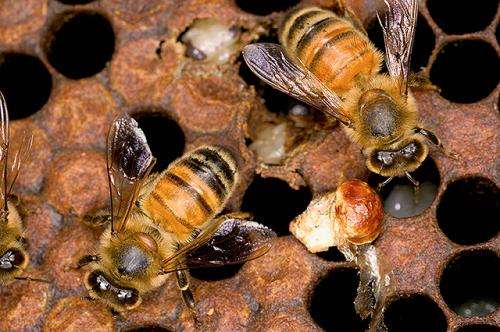Disinfecting honey comb with ozone

Sometimes even honey bees need help with "housekeeping," especially when it comes to cleaning their honeycombs once the honey's been removed. U.S. Department of Agriculture (USDA) research has shown that fumigating honeycombs with ozone gas can eliminate pests and pathogens that threaten honey bee health and productivity. Now, ozone fumigation may also help reduce pesticide levels in honeycombs.
The findings come from a two-part study led by entomologist Rosalind James with the Pollinating Insects-Biology, Management, and Systematics Research Unit operated in Logan, Utah, by USDA's Agricultural Research Service (ARS). Results from the first part of her team's study, published in 2011 in the Journal of Economic Entomology, demonstrated that fumigating honeycombs with ozone gas at concentrations of 215 to 430 parts per million (ppm) killed all life stages of the greater wax moth, depending on length of exposure.
Ozone, a highly reactive state of oxygen, also destroyed spores of the chalkbrood fungus after 24 to 36 hours of exposure using 1,500 ppm. Another honeybee pathogen, the American foulbrood bacterium, required substantially longer exposure times and an ozone concentration twice as high.
Both pathogens can persist for years on beekeeping equipment and in hives as dormant spores. They germinate when conditions are optimal, and attack the colony's larvae. Methyl oxide and gamma irradiation are among treatments that have proven effective for disinfecting honeycombs, but these treatments can be costly and impractical, according to James. An ozone fumigation chamber is something beekeepers can set up on their own.
In January 2013, James' team published results from the second part of the study in the journal Agricultural Science. That paper details ozone's breakdown of coumaphos, fluvalinate, and several other pesticides that can accumulate in hives.
Higher ozone concentrations and longer exposure times were required to reduce pesticide concentrations in wax and honeycomb samples. The treatments also degraded the pesticides better in new honeycombs (less than three years old) than in older ones (more than 10 years old).
More information: The study results are available online: www.todayscience.org/AS/v1-1/A … 471.2013.0101001.pdf
Journal information: Journal of Economic Entomology
Provided by Agricultural Research Service


















